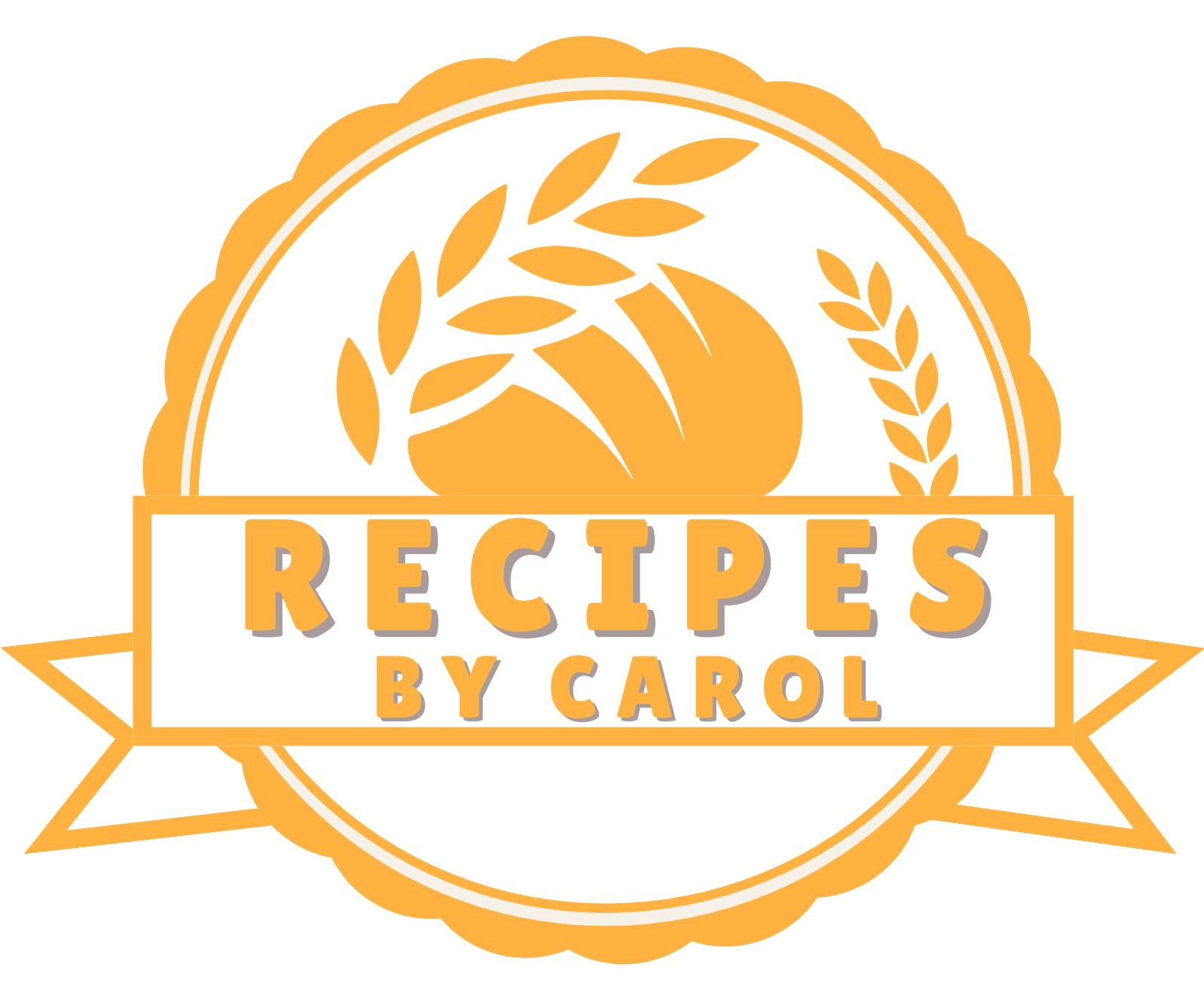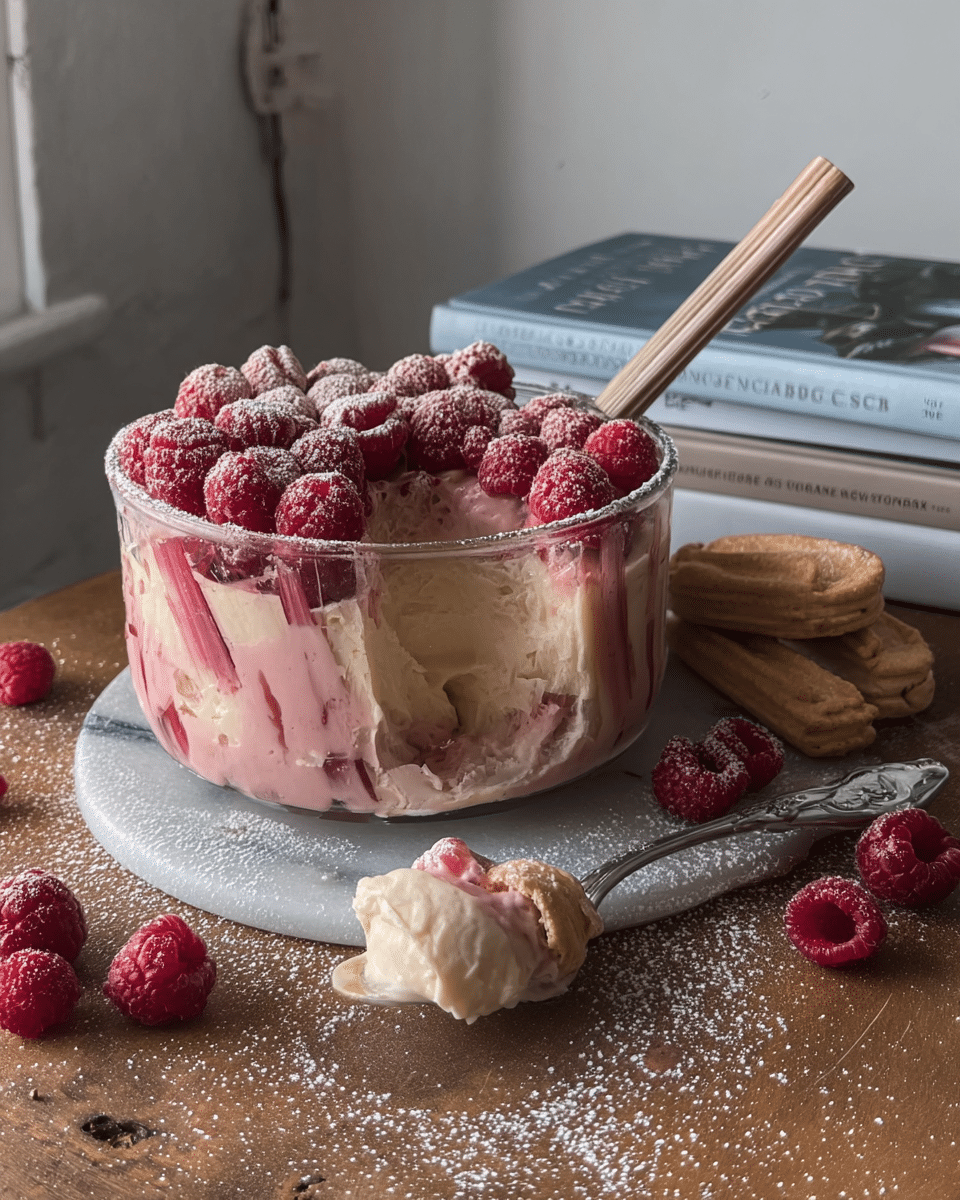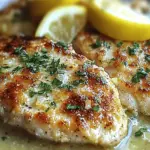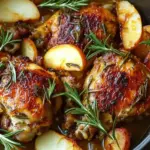This Rhubarb Custard Trifle is a dreamy, no-bake dessert layered with silky cardamom custard, tart rhubarb compote, and juicy raspberries. Each bite melts into a harmony of textures from crisp Nilla wafers softened to perfection to the pillowy cream blended with vanilla and spice.
Perfect for summer gatherings or cozy Sunday dinners, this make-ahead trifle is as beautiful as it is delicious. Served in a glass bowl to showcase its pastel layers, it’s a showstopper on any dessert table. Plus, with its chill-and-serve simplicity, it’s stress-free sweetness at its finest.
Full Recipe:
Ingredients:
Rhubarb Compote:
-
500g rhubarb, trimmed and chopped
-
50g granulated sugar (add more if using regular rhubarb)
-
Juice of 2 oranges
Vanilla Cardamom Cream:
-
50g cornstarch
-
150g granulated sugar (divided: 100g + 50g)
-
500g whole milk
-
1/4 tsp fine sea salt
-
1 tsp vanilla bean paste or extract
-
4 large egg yolks
-
1/2 tsp ground cardamom seeds (optional but recommended)
-
40g salted butter, softened
-
400g heavy whipping cream, cold
Other Elements:
-
60 Nilla wafers (or to taste)
-
650g fresh raspberries, rinsed and dried
Directions:
1. Prepare the Rhubarb Compote:
-
Place chopped rhubarb, sugar, and orange juice in a medium pot over medium-low heat.
-
Cover and cook for 5 minutes until it begins to bubble.
-
Uncover and stir every 5 minutes, simmering until thick and syrupy.
-
Transfer to a shallow bowl and let cool to room temperature. Store covered in the fridge until ready to use.
2. Make the Vanilla Cardamom Cream:
-
In a pot, whisk cornstarch with 100g sugar. Add milk, then yolks, salt, vanilla, and cardamom. Mix well.
-
Place over medium-low heat, whisking constantly until thickened.
-
Remove from heat and whisk in butter.
-
Pass through a fine sieve into a bowl, cover with plastic wrap, and cool completely.
-
In a separate bowl, whip the cold cream and remaining 50g sugar until medium-stiff peaks form.
-
Whisk the cooled custard, then fold in the whipped cream in three additions.
3. Assemble the Trifle:
-
Start with a layer of Nilla wafers in a clear bowl.
-
Add ~½” of cream, a layer of rhubarb compote, and some raspberries.
-
Add ~¼” more cream, then repeat: wafers, cream, rhubarb, raspberries, finishing with ~½” cream layer.
-
Cover with plastic wrap and chill for at least 12 hours.
4. Serve:
-
Before serving, top with more raspberries or crushed wafers.
-
Scoop and serve with a spoon or ice cream scoop.
Prep Time: 30 minutes | Cooking Time: 30 minutes | Chilling Time: 12 hours | Total Time: 13 hours
Kcal: 303 kcal | Servings: 18
The Elegance of a Rhubarb Custard Trifle: A Timeless Dessert with a Seasonal Twist
There are few desserts as visually stunning and universally pleasing as the classic trifle. Towering layers of cream, fruit, sponge or biscuits, and custard have graced tables for centuries, particularly in British and European households. But when you pair the nostalgic elegance of a traditional trifle with a fresh, seasonal twist like tart rhubarb, fragrant cardamom, and the crisp simplicity of Nilla wafers you get something truly special: the Rhubarb Custard Trifle.
This dessert is a beautiful intersection of rustic charm and refined indulgence. It’s designed for both presentation and flavor, offering a spoonful that balances creaminess, tart fruit, and sweet cookies in perfect harmony. Whether you’re preparing for a garden party, Easter brunch, or just a cozy summer evening at home, this trifle is sure to deliver comfort and delight.
The Trifle Tradition: A Brief History
The word “trifle” itself originates from the old French term trufle, meaning something whimsical or of little consequence. But make no mistake there is nothing trivial about the satisfaction this dessert brings. Trifles have been around since at least the 16th century, evolving from simple flavored creams to the elaborate layered confections we enjoy today.
Traditionally, trifles are built with sponge cake (often soaked in sherry), layers of fruit or jam, custard, and whipped cream. Over time, each region and generation has developed its own interpretation. What remains unchanged is the trifle’s theatrical layering and indulgent texture play.
This modern adaptation, the Rhubarb Custard Trifle, celebrates that tradition while offering a modernized, no bake version that’s quicker to prepare but no less luxurious.
Why Rhubarb?
Rhubarb is one of those ingredients that signals the arrival of spring and early summer. Its stalks, ranging from pale green to vivid fuchsia, are as beautiful as they are tart. Although rhubarb is botanically a vegetable, it’s typically used as fruit in desserts paired with sugar to mellow its natural acidity.
In this trifle, rhubarb is transformed into a compote by simmering it gently with orange juice and sugar, producing a bright, jammy layer that contrasts beautifully with the richness of the custard. The tartness keeps the dessert from becoming cloying and introduces a refreshing zing that awakens the palate.
Raspberries are also included either as a fresh layer or blended into the compote to reinforce the berry brightness and add visual appeal. The combined pink tones of rhubarb and raspberry are both festive and elegant, perfect for a layered dessert designed to impress.
Custard with a Twist: Cardamom’s Role
Custard is the heart of any good trifle. It provides body, richness, and a creamy counterpoint to the fruit. This particular version elevates the custard by incorporating cardamom a warm, citrusy spice often found in Scandinavian and Middle Eastern baking.
Cardamom is not overpowering here. Instead, it adds an aromatic undertone that deepens the flavor of the vanilla custard. It makes the dessert feel both traditional and subtly exotic, like a classic English pudding with a modern global spin.
The custard is further lightened by folding in freshly whipped cream, transforming it into a mousse-like filling that’s soft, silky, and luxurious. When layered with tart fruit and crisp cookies, it offers a textural balance that feels indulgent without being heavy.
Texture, Layering, and the Importance of Contrast
A great trifle doesn’t just taste good it feels good in the mouth. The genius of this dish lies in its contrasting textures: the crumble of cookies, the silk of custard, the burst of berries, and the melting compote. This recipe uses Nilla wafers instead of traditional sponge cake, which may seem like a humble choice, but proves to be genius.
Nilla wafers soften just enough when layered with cream, absorbing moisture to become cake like while retaining a bit of their structural integrity. This makes the trifle more accessible no baking, no slicing cake into pieces, no soaking with alcohol just build, chill, and serve.
What’s more, the use of a clear trifle bowl or glass dish enhances the visual aspect of the dessert. You see the pink and cream layers stacked in repetition, building anticipation before the first spoonful.
Make-Ahead Magic
One of the most appealing aspects of this dessert is that it’s meant to be made in advance. Unlike many desserts that must be timed precisely before serving, the rhubarb custard trifle improves as it sits. A 12-hour chill allows the wafers to soften, the layers to set, and the flavors to meld into one cohesive experience.
This make-ahead quality makes it an excellent choice for entertaining. You can prepare it the night before a gathering and focus on the rest of your menu, knowing that your dessert is quietly transforming into its best version in the fridge.
And unlike more delicate pastries or frozen treats, trifles are forgiving. They travel well, hold their shape, and taste just as good the next day if not better.
Substitutions and Variations
Another reason this dessert is such a crowd-pleaser is its adaptability. If you can’t find rhubarb, white peaches or even just fresh raspberries can be used to mimic its bright-tart flavor and pink hue. A peach-raspberry compote, cooked in the same method, provides a slightly sweeter variation that works beautifully in late summer.
For those avoiding gluten, gluten-free vanilla cookies can easily be substituted for Nilla wafers. If you prefer a more traditional base, pound cake or ladyfingers (savoiardi) work well too.
The cardamom is optional but recommended. If you’re not a fan or don’t have any on hand, stick with vanilla or experiment with lemon zest, almond extract, or even rosewater for a floral twist.
Presentation Ideas
Serving a trifle is all about visual drama. Whether you opt for a traditional trifle dish, a large glass bowl, or even individual mason jars for a more rustic presentation, you’ll want to showcase those colorful, creamy layers.
Toppings can include fresh raspberries, a dollop of whipped cream, a sprinkling of crushed wafers, or even a few edible flowers for a special touch. Serve with a large spoon or ice cream scoop, and don’t worry about messy portions trifle is meant to be spooned with abandon.
A Dessert for Every Occasion
This Rhubarb Custard Trifle is incredibly versatile. It shines on spring holiday tables like Easter or Mother’s Day. It’s refreshing enough for summer BBQs and picnics. It’s comforting enough for rainy day baking. And because it’s so visually stunning, it also makes a statement as the grand finale to a dinner party.
It’s nostalgic yet fresh. Elegant yet easy. And most of all, it’s a reminder of why layered desserts continue to endure in our culinary traditions: they tell a story of flavors coming together, textures mingling, and time doing its gentle work in the fridge.
Conclusion:
At its core, the Rhubarb Custard Trifle is a dessert that celebrates contrast and balance sweet and tart, creamy and crisp, old fashioned and new. It takes the bones of a centuries-old British favorite and brings it into today’s kitchens with simple ingredients and bold flavors.
More than a recipe, it’s an experience one that rewards the patient (chilling overnight is non-negotiable), delights the eye, and comforts the soul. If you’re looking to add a signature dish to your spring or summer repertoire, this is it.
Whether you’re a seasoned baker or a weekend home cook, this trifle proves that dessert can be both dazzling and do able. And when that first spoonful hits the table, layered with love and flavor, you’ll know it was worth every step.






